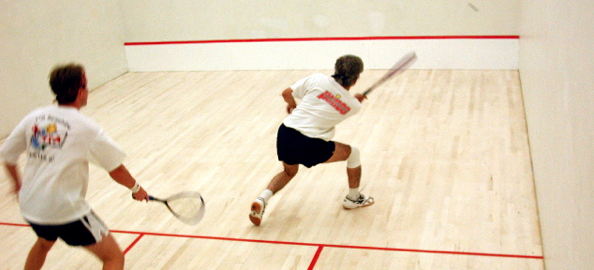Editor-in-Chief
Squash, I know, involves rackets. It may or may not involve a net, or maybe they knock the ball off a wall. I remember something in elementary school, generally called wall ball, called something to do with a pig in my school, but I never played it.
So here are the facts.
Squash is a two-player game in a four-walled court. It is also quite high speed and requires much mental agility, leading many involved to regard it as a sort of extremely fast chess game. The ball they use is a soft, hollow, and ‘squashable’.
The balls each have a colored dot to display what level of play they are used for; they are made out of different types of rubber and other materials to change how much the ball bounces and how it plays. Beginners play with blue, fast balls and experts play with double yellow dot balls which are very slow. Tournament play uses double yellow dot balls.
The history of squash is unique. It’s relatively new; the first squash court in North America appeared at St. Paul’s School in New Hampshire in 1884. Before that, it had been developed at Harrow School in England in about the 1830s. In Philadelphia, PA, US-Squash was formed in 1904, originally called United States Squash Racquets Association, (USSRA), then the earliest national association of squash in the world. Now, the sport is played in over 180 countries, and efforts are underway to have squash qualified as an Olympic sport before the 2020 Olympic Games.
Actual gameplay was originally derived from Tennis, and in some fashions still resembles the French sport.
Typical scoring in squash is called point-a-rally scoring (PARS), in which each player gets a point when he or she wins a rally, regardless if he or she was the one to serve. The games are played to 11 points, but the match must be won by a clear two points. Both the men’s and women’s professional tours utilize this scoring method, in part so the matches will be shorter.
The original scoring system was called English scoring, and a player would only be awarded a point if they won their own served rally. If they won a rally that they did not serve, they would merely begin to serve and not be awarded a point. These matches are played until nine points. If the score reaches 8-8, the player who reached eight points first decides to play “set one” or “set two,” where the game is played until nine, as originally, or until 10, respectively.
A referee, or in tournament play, three referees, decide the scoring and rulings.
There are two service boxes on the court where players serve the ball from. The first serve is decided by twirling a racket and the players call which direction the logo on the handle will be facing. Then the player who wins decides which service box they would like to serve from, and the players begin to play the ball off the wall between two lines called the service line and the tin, which is usually 19” from the ground. The other player has to hit the ball back to this area before it bounces twice or hits a foul area, and the players do this back and forth until one player fails to return the ball.
This process is called a rally. Each time a rally ends, the players switch which service box the ball will be served from. In addition, the server must always have one foot in his or her service box. The most common type of play is called “dominating the T,” which is the best spot to receive an opponent’s shot. There are many types of shots a squash player can use; a very common one is bouncing the ball off one or more of the side walls and into a back corner of the court. These are the basic rules of play, which obviously become more nuanced.
The team here at F&M is Division 1, which means our players are very good and very competitive. In fact, our men’s team is currently ranked seventh and has just advanced their record to 9-3 after beating 11th-ranked Williams College. They will play Saturday at Hamilton College. The number 15 women’s squash team are currently 5-7, having lost to number 10 Williams at the last game. They will also play at Hamilton Saturday.
There is also a club at F&M called Squash Attitude, Community, Excellence, and Scholarship (A.C.E.S.), which is an athletic and community-service oriented program launched in 2009 to help urban kids get involved in sports and a meaningful after-school opportunity.
The club has partnered with the Lancaster School District to provide students with squash equipment, courts, programming, mentorship, classrooms, and volunteers to underserved middle and high school students.
Squash will continue to be a big deal at F&M and the world over. I enjoyed learning about this interesting and nuanced sport, and will continue to learn its intricacies.
Questions? Email Lauren at lbejzak@fandm.edu.
